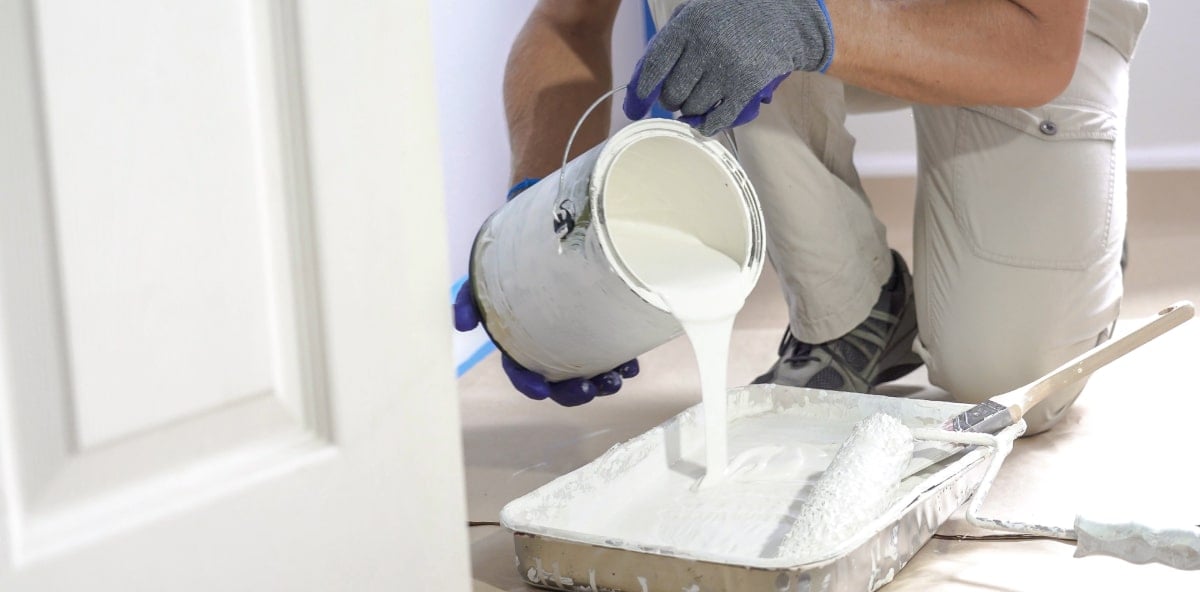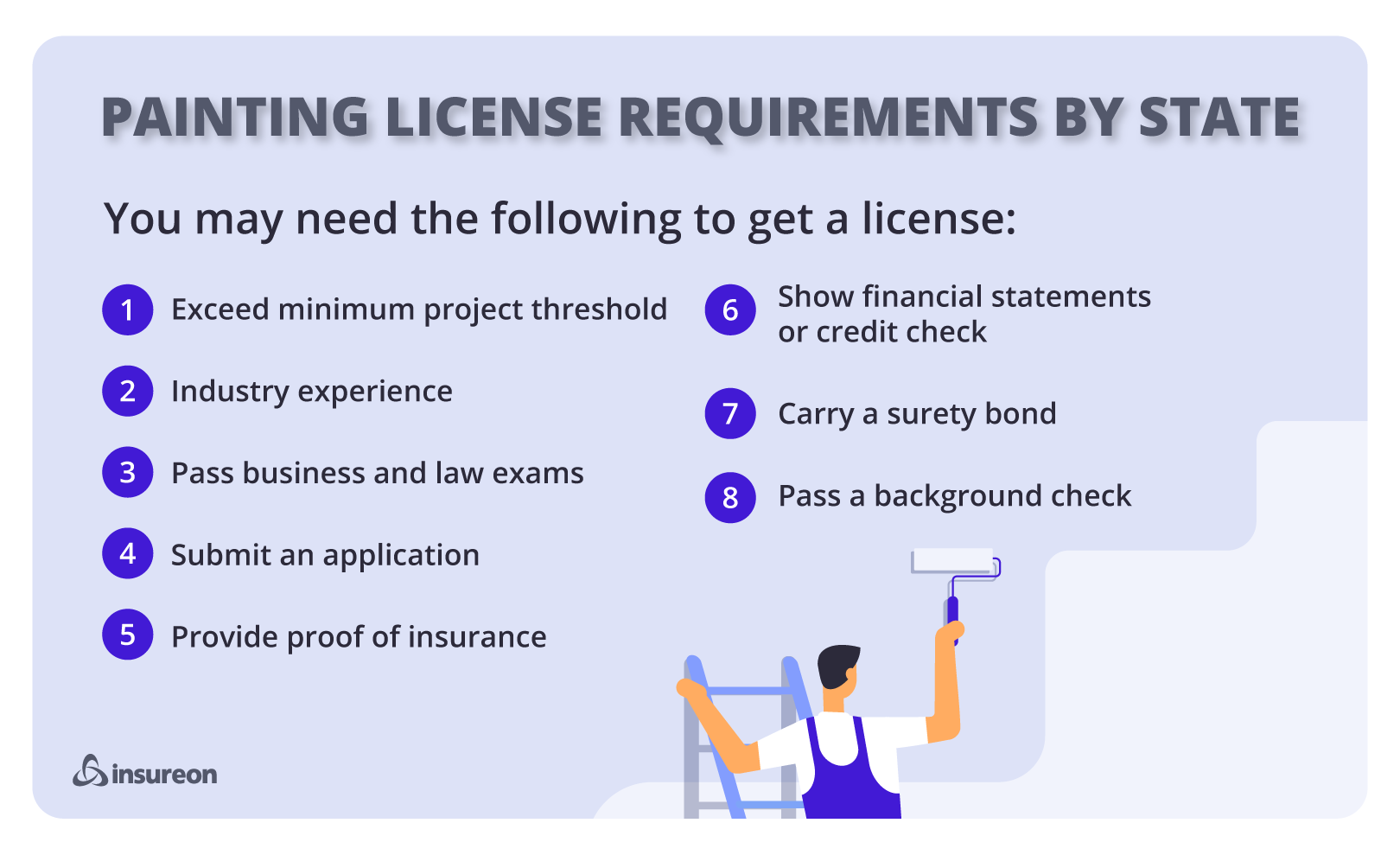Painting license requirements in 2025

What it takes to be a painter in 2025
Years ago, painting was seen as an odd job college students would take on during the summer to make a little extra cash. But these days, being a painter is a worthy occupation, and one that’s filled with potential. From 2023 to 2033, the U.S. Bureau of Labor Statistics expects 4% growth for the occupation. And U.S. News & World Report ranks it as the 9th best job in construction.
Becoming a professional painter, either in residential or commercial settings, takes some planning, though. You have to be set up with the proper credentials and protections to operate legally and establish yourself as a reputable company. That means knowing what the regulations are for where you’re located.

What insurance coverage does a painter need?
States dictate what type of insurance is needed for painters. However, there are a few types of policies that are seen as standard in this line of work.
General liability insurance: General liability insurance should be the first financial shield for every small business. It can save you from a lot of unexpected expenses, which can happen suddenly and add up quickly.
For example, if while carrying a ladder through a building, a light fixture or window is broken, general liability would cover the property damage. It also pays for third-party injuries. If you’re sued by a third party for damage or injury you or your employee caused, general liability insurance would handle those expenses as well.
For extra savings, a general liability policy can be bundled with a commercial property policy. This is known as a business owners’ policy (BOP).
Workers’ compensation insurance: In all states but one, workers’ comp is generally required as soon as you hire your first employee, regardless of industry. However, workers’ compensation coverage is even more important in construction, where there are often high-risk trades operating around each other.
Workers’ comp would pay for expenses if an employee gets injured on the job. That includes medical bills, lost wages, and death benefits. It typically also includes employers’ liability coverage, which would handle any costs related to lawsuits filed by an injured employee.
This policy typically isn’t an insurance requirement for sole proprietors with no employees. But it may be smart to get a policy anyway, because your health insurance would deny any claim that stems from your work. That means if you’re injured on the job, medical expenses would be your responsibility. However, if you’re self-employed and have workers’ compensation insurance, it would kick in to cover your healthcare costs.
It’s important to check local regulations, because some states, like California, require sole proprietors with no employees to carry worker’s comp if they have specific construction licenses, like roofing, asbestos, HVAC, concrete, and tree service. But starting in 2026, California will require all contractors to have workers’ compensation protection.
Tools and equipment insurance: Painting requires a specific set of tools. And painters are on different job sites all the time. That’s the kind of scenario tools and equipment insurance was created for. It protects mobile tools and equipment that are lost, stolen, or damaged. While commercial property insurance covers tools and equipment as well, it only applies to items permanently kept at a specific business address.
However, tools and equipment insurance only covers property valued at less than $10,000. If your tools and equipment exceed that amount, then you may want to look into a more general type of inland marine insurance, which does the same thing without the value limit.
Commercial auto insurance: If your painting business owns any vehicles, then you most likely need commercial auto insurance. Only one state is exempt from this law. Your commercial auto liability policy will pay for a third-party’s medical expenses, property damage, and legal expenses related to a car accident you or one of your workers caused. Additional protections, like comprehensive coverage, uninsured motorist, or physical damage coverage can also be added. States determine policy limits and what coverage you need.
If your business doesn’t own its vehicles, but instead rents or leases them, or if your employees use their personal vehicles for jobs, then you’ll want to look into a hired and non-owned auto (HNOA) insurance policy.
Professional liability insurance: This is also referred to as errors and omissions (E&O) insurance or professional indemnity insurance. This type of policy protects you from lawsuits filed by unsatisfied clients. You may not think you need E&O insurance as a painter, and in some cases that’s true.
For example, if you made an error and painted every wall in a 10-story building the wrong color, then your client probably won’t sue you—they’ll just force you to repaint it the right color. However, if that mistake delayed or voided a real estate closing, then it might trigger a lawsuit. Or, if you missed a deadline entirely and prevented a property from getting on the market, that could initiate legal proceedings as well. Professional liability insurance would pay to help you defend yourself in court.
What other types of legal protections do painting contractors need?
Another kind of financial instrument that painting contractors should be aware of is a surety bond. These are legally binding contracts that serve as a guarantee that work will be completed and the client will be paid if it’s not. It demonstrates your financial responsibility to the project.
A surety bond has three parties: the principal, who is doing the work; the obligee, or the client or project owner; and the surety, who underwrites the bond. A big difference between insurance and a surety bond is you have to pay the guarantor back for any bond claim that’s paid out.
Surety bonds not only show you’re reliable, but they’re necessary to work with some clients, especially government agencies. Bond requirements vary by state. There are different types of surety bonds, but the ones most common in the construction industry are:
- License bonds (also known as permit bonds)
- Contract bonds (also known as performance bonds or construction bonds)
- Bid bonds
- Performance bonds
- Payment bonds
- Maintenance bonds
- Fidelity bonds (also known as employee dishonesty bonds)
Why painter licensing matters
States create licenses to establish occupational standards. By having a painting contractor license, you demonstrate professionalism and a commitment to those industry standards. It also shows you’ve gone through the necessary training, passed exams, secured necessary insurance and bonds, or whatever else is mandated where you’re located.
Moreover, if you operate somewhere that requires a painter’s license and you don’t have one, you may be subject to penalties. Failure to comply can result in fines and legal issues, plus a loss of business opportunities.
Painting license requirements by state
Each state determines eligibility and sets up its own qualifying conditions when it comes to licensing painting contractors or subcontractors. It prescribes what’s needed to obtain one, including insurance, testing, and experience requirements.
In some cases for licensure purposes, a painter is classified as and receives a general contractor license. Or, there may be a subset as a specialty contractor or home improvement contractor. The kind of work you do may impact your application process as well. Residential contractors can have different requirements for their types of licenses than those who do commercial painting.
Do painters need a license in Arizona?
Yes, Arizona requires painters to hold a Painting and Wall Covering Contractor license (C-34, R-34 or CR-34) from the Arizona Registrar of Contractors. Applicants must:
- Provide proof of experience
- Pass state exams
- Obtain a surety bond (amount depends on the license type, either residential, commercial or dual)
- Undergo a background check
Do painters need a license in California?
Yes, California requires painters to hold a C-33 Painting and Decorating Contractor License from the Contractors State License Board (CSLB) if the project exceeds $500. Applicants must:
- Have four years of journeyman-level experience
- Pass two state exams
- Show proof of insurance
- Secure a contractor’s bond
- Undergo a background check
Do painters need a license in Louisiana?
Yes, Louisiana requires painters to hold a license issued by the Louisiana State Licensing Board for Contractors if the project is $50,000 or more. Applicants must:
- Pass state exams
- Show proof of insurance
- Obtain a surety bond
- Meet the financial requirement
Do painters need a license in Nevada?
Yes, Nevada requires painters to hold a C-4 Painting and Decorating Contractor license from the Nevada State Contractors Board. Applicants must:
- Have four years of experience
- Pass state exams
- Secure a surety bond
- Meet the financial requirement
Do painters need a license in North Carolina?
Yes, North Carolina requires contractors to hold a license issued by the North Carolina Licensing Board for General Contractors if the project costs $40,000 or more. Applicants must:
- Pass a state exam
- Meet the financial requirement
Do painters need a license in Tennessee?
Yes, Tennessee requires contractors to hold a license issued by the Tennessee Licensing Board for Licensing Contractors if the project is $25,000 or more. It is not only required before you begin work, but even before you bid on a job. Applicants must:
- Pass state exams
- Show proof of insurance
- Meet the financial requirement
- Provide a reference
Do painters need a license in Utah?
Yes, Utah requires painters to obtain an S270 Drywall, Paint, and Plastering Contractor license from the Utah Division of Occupational and Professional Licensing. To qualify, applicants must:
- Show proof of insurance
- Complete a pre-license course
Which states don’t require a painter’s license?
There are several states where you don’t need a license if you’re a painter. Even some states that do mandate a license waive the requirement if painting projects fall under a certain minimum threshold. For example, in Louisiana, painting jobs have to be billed at $50,000 before a license is necessary.
Here are the states that currently don’t require a painter’s license:
- Colorado
- Connecticut
- Delaware
- Florida
- Idaho
- Illinois
- Indiana
- Iowa
- Kansas
- Kentucky
- Maine
- Minnesota
- Missouri
- Montana
- Nebraska
- New Hampshire
- New Jersey
- New York
- Ohio
- Oklahoma
- Pennsylvania
- Rhode Island
- South Dakota
- Texas
- Vermont
- Washington
- Wyoming
While those listed above don’t have licensing requirements for painting contractors at the state level, local governments may have their own set standards. It’s advisable to check with authorities where your company operates to ensure compliance with all applicable laws and regulations regarding local licenses.

How do you get a painter’s license?
If you’re just starting your small business, you may wonder, “Is it hard to get a painter’s license?” Thankfully, if you know what you need—and that depends on where you live—the licensing process can be fairly straightforward. Here’s a simple checklist of things you’ll likely run across to qualify for a painter license:
- Meet experience requirement: Typically 2-4 years of work experience at the journeyman or supervisory level is necessary. Coursework may also count toward the time obligation.
- Pass licensing exam: Most states require passing a business and law and/or trade exam.
- Obtain insurance: General liability and, if you have employees, workers’ compensation insurance are often mandatory.
- Secure a surety bond: Many states may require this type of financial guarantee to protect your clients if something goes wrong.
- Meet the financial requirement: You may need to hand in personal or business financial statements to demonstrate stability.
- Pass a background check: Some states may look into your criminal history or require fingerprinting.
- Submit application form and license fee: Provide all necessary paperwork and pay relevant application fees.
After you receive your painter’s license, it’ll need to be renewed to stay current. Most states’ business licenses are good for 2-4 years, but a few are only valid for one year. In some cases, you’ll need to complete continuing education to qualify for renewal. These credits could include information about industry best practices or building code and safety regulation changes.
Even if your state or municipality doesn’t handle licensure for painters, it may be worthwhile to obtain a voluntary certification because it builds credibility for your business. A certified contractor demonstrates to potential clients they’re responsible, conscientious, and professional. That could lead to more contracts.

Get painter’s insurance quotes with Insureon
Start your path towards becoming a painting contractor today with Insureon. By filling out our brief online application, our expert agents will put together quotes from top-rated U.S. insurance companies. After you compare rates, you can get your policy started in less than 24 hours and get access to documents like your certificate of insurance (COI) through our easy-to-use online portal.
Sara Singh, Contributing Writer
Sara’s career has taken her across the writing spectrum. She started as a television news producer, then was hired as the marketing manager for a financial services firm. After working for the publisher of the world’s most widely circulated magazine, Sara went into the agency scene as a copywriter and finally served as the in-house content writer for a tech consultancy. Now, she freelances for a variety of clients so she can have the flexibility to do volunteer work and travel.









